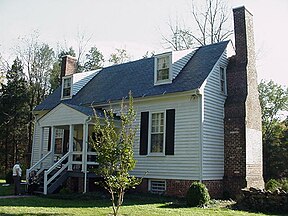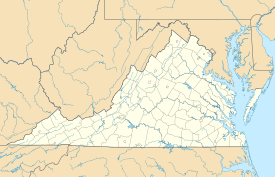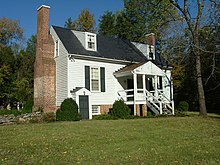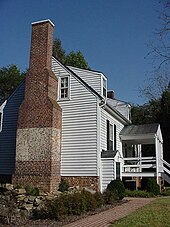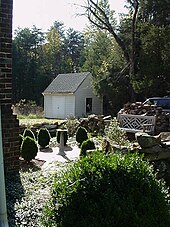Locust Grove (Dillwyn)
| Peter Francisco House | ||
|---|---|---|
| National Register of Historic Places | ||
|
Front view on Locust Grove |
||
|
|
||
| location | near Dillwyn , Buckingham County , Virginia | |
| Coordinates | 37 ° 29 '2 " N , 78 ° 22' 9" W | |
| Built | before 1794 | |
| NRHP number | 72001386 | |
| The NRHP added | March 16, 1972 | |
Locust Grove is a historic house between Dillwyn and Buckingham in Buckingham County in the US state of Virginia . It was built before 1794 and is known as the Peter Francisco House through its association with revolutionary Peter Francisco . Under this name, it was added to the National Register of Historic Places on March 16, 1972 .
description
Locust Grove is a one and a half story house with a gable roof and two dormers on each side of the roof. A cornice forms the basis for the roof. At each end of the building there are two chimneys, the eastern one is bricked in the Flemish Union and is original. The western chimney built in the English Association seems to be a replacement from a later time and was probably built when the house still had a one-story wing. This side wing no longer exists, but the foundation of its chimney is still visible. A small garden was created in place of the former side building. The base of the building is bricked in the English Association, the building has a full basement . When the house was nominated for the National Register of Historic Places, the window frames and shutters were original, as was much of the wood paneling. The components of the house made of pine are joined together with wooden pins and nails made of wood.
Inside, the house is divided into two main rooms on each floor, the stairs to the upper floor are in the central hall. Little has been preserved of the original interior. Fireplace surrounds and paneling were removed, as were some of the floorboards on the second floor, some of which had been broken off. Part of the stairs and the northern exit door are original. The walls were once partially tiled, but much of it has crumbled over time.
Locust Grove has suffered over time and was assessed as "deteriorated" at the time of the assessment for entry in the National Register of Historic Places . Most of the frame construction has withstood time, however, and allows a look into the construction of the house, although many of the decorations inside and outside the building have disappeared. Thanks to extensive restoration work, the house is now in a habitable condition again.
location
Locust Grove is located approximately one and a half kilometers off Virginia State Route 626 near the Buckingham County's border with Cumberland County . The entrance to the house is from the north. The house is at the end of a dirt road in the middle of farmland and scrub. The house is on the edge of a mountain above Payne Creek , fairly isolated from the surrounding community. When it was built, the house was connected to the old carriage road that once ran from Richmond to Appomattox ; During archaeological excavations, remnants of the old street bed were discovered not far from the house.
history
Little is known about the beginnings of the house. It has been proven that it was built before 1794, as Francisco took up residence in that year. He lived here until the mid-1825s. One source cites the year 1785, while another assumes a date between 1790 and 1810 based on the style. Francisco himself had a bond with the area - he grew up in Hunting Towers, the nearby estate of Patrick Henry's uncle, Judge Anthony Winston. How Francisco became the owner of the land on which Locust Grove stands is unknown; family history tradition suggests that he received it from the planter James Anderson, the father of his first wife Susannah. In any case, he lived here with his second wife Catherine Brooke, with whom he raised four children together. She died in 1821; two years later he married again, this time to a widowed niece of Governor Edmund Randolph . She eventually persuaded him to abandon the country life in favor of a more comfortable life in Richmond, where he served as chief regulatory officer for the Virginia Senate and where he remained until his death.
Little records have survived from the time of Francisco on Locust Grove. This sparse information suggests that the farm was typical of Virginia in the early 19th century. An inventory drawn up in 1815 to determine a personal wealth tax records that there were seven slaves over twelve years old in the household and one between nine and twelve years old, as well as six horses and twelve head of cattle . Could not find a coach or clock, no furniture from mahogany , but the budget had taxes for a mirror with forged frame, two goblets of crystal glass dissipate, three images and an unknown number of gilded frames. So Francisco was not part of Virginia's better society at the time, but probably among the county's wealthy residents.
Peter Francisco died in 1831; the next known owner of Locust Grove was Robert Rives, who briefly owned it in 1845. From him ownership passed to John S. Coleman, who lived there until 1906. The next owner was Abner Spencer and lived here until after 1932. The Society of the Descendants of Peter Francisco began looking after the property in the early 1970s and rented it for the symbolic price of one US dollar a year. The intention was to restore the house and turn it into a museum dedicated to the memory of Francisco. The restoration of the house was completed, in part due to the allocation of matching funds by the United States federal government for entry on the National Register, but the museum was never built and the house became private property.
Archaeological excavations
As part of the restoration of Locust Grove in the late 1980s, the property was visited by students at Longwood College who carried out archaeological digs at five different locations on the property. The most important of these was the discovery of a toddler's grave in a corner of the former herb garden near the house. Oral tradition says that Francisco had a daughter in the 1820s who died as a toddler and was buried in the garden, but official records of such funeral or birth do not exist. The discovery of the tomb gave the oral tradition greater credibility. The remains of the foundations of a tobacco drying shed , which burned down in 1826, as well as ashes, nails and fragments of nails were also found on the grounds of the property . The excavations also unearthed the foundations and cellar of an old ice house , which was later used as a garbage pit, and the foundation walls of another smaller building, the purpose of which is unclear and a small spring. Numerous original beams as well as door and window frames of the house were also found and replaced during the restoration. The originals were stored in the basement of the house for further investigation.
Remarks
- ↑ The certified copy of Anderson's will states that part of his property will pass to Susannah and her husband after his death; the will expressly states the area of the property to be bequeathed, but does not state any location. It is likely that Locust Grove was built on the property the couple inherited, but there is no definitive evidence of this.
- ↑ Francisco mentioned the loss of a year's tobacco crop in a letter written to the Virginia General Assembly in 1826 , justifying his request for the payment of pension payments due from his military service.
Individual evidence
- ↑ a b c d e f Virginia Historic Landmarks Commission: Peter Francisco House ( English , PDF, 32 kB) In: National Register of Historic Places Inventory-Nomination . Virginia Department of Historic Resources. January 1972. Archived from the original on March 18, 2009. Info: The archive link was automatically inserted and has not yet been checked. Please check the original and archive link according to the instructions and then remove this notice. Retrieved March 10, 2009.
- ↑ a b c d Ralph A. Ricer: Buckingham's Francisco ( English ) 1971, p. 32.
- ^ A b James W. Jordan, Kent Booty: Catching up with the Past: Archeology at Locust Grove . In: Olde Times . 3, No. 1, 1988, pp. 2-11.
- ↑ a b c The Restoration of 'Locust Grove': Bringing Francisco's Home Back To Life. (English) . In: The Daily Progress , February 15, 1976.
